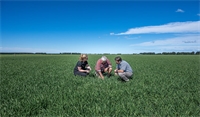May Agronomy Update by Bill Cabout, Ruralco’s Ashburton Store Manager
Fodder Crops
Fodder crops are looking good with all the regular rain we have been receiving.
As the days get shorter and cooler, the Fodder Beet bulbs will continue to develop in size. While it is too early to estimate yields it will be interesting to see how the earlier grazed crops perform. Some farmers are looking to transition and feed crops from April onward, and we may see some variation in paddocks from commencement to the end of grazing as the crop continues to grow. The best way to get accurate yield calculations is to use an independent feed assessor, even if the crop is for your own use. This will help the transitioning process and welfare of animals in the early grazing stages.
Kales crops have reached a good size this year with consistent growth across most paddocks so we should see good yields.
Autumn Sown Crops
Slug control is crucial, especially in irrigated fields with a lot of trash. Paddocks need to be monitored, and slug bait applied as needed. It is cheaper to control slugs than to redrill a crop.
Pre-emergence sprays are necessary to control weeds. For wheat, use Firebird or Invado for hairgrass, and consider using terbuthylazine for a broader range of weeds. Avadex Extra can help control wild oats pre-sowing. Sakura is a new herbicide for controlling various grasses and weeds.
For wheat, pairing cultivars with appropriate sowing dates and managing plant populations are critical for achieving high yields. For barley, Firebird or Invado can be used similarly.
For clover, after drilling Armanda/Preside gives good control of certain weeds and you don’t need to be concerned about the clover size.
Most grass seed crops have been planted by now. Just be aware of slugs and grass grub and take the necessary steps to control these. With good growing conditions this year an early post emergence spray is worth considering to control any weeds that have appeared in the paddocks. What to use will depend on your weed spectrum.
Monitoring Stored Grain
Monitoring grain during storage is a valuable tool in maintaining quality. This becomes more important the longer the grain remains in storage because deterioration in seed quality early in storage is slower, and insects are sparse and not easily noticed. Temperature and seed moisture content are important indicators of grain quality that influence insect and mould activity. Once grain is in storage, monitoring for insects and mould once a month will give early notice of any problems occurring so action can then be taken to control these problems.
With all the above scenarios talk to your Ruralco representative for the best options for you and your situation.
Related

The end of November, early December has finally brought some settled sunshine across the region, wit...
Read More

For the next 2 months we are looking at the final sprays for finishing off our cereal and grass seed...
Read More

Growing forage brassica crops for summer or winter feed take planning. Insect pests can limit brassi...
Read More

November’s Agrichemical Update focuses on getting the most from your spray programme. We cover cere...
Read More

November has kicked off in true Canterbury style with a dusting of Labour weekend snow. It’s been a...
Read More

Arable growers have launched a logo to champion NZ-grown grains in bread and cereals. With most supe...
Read More